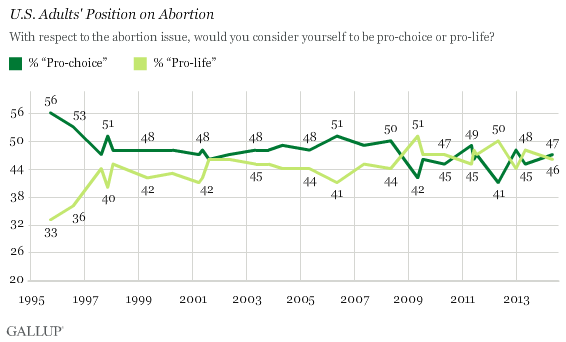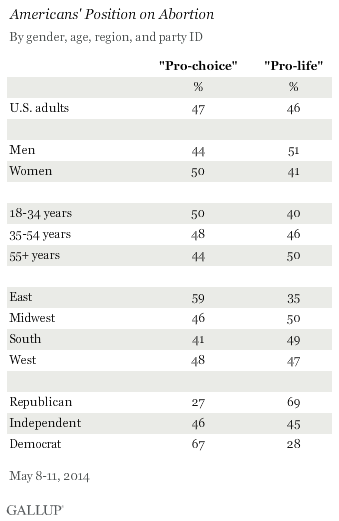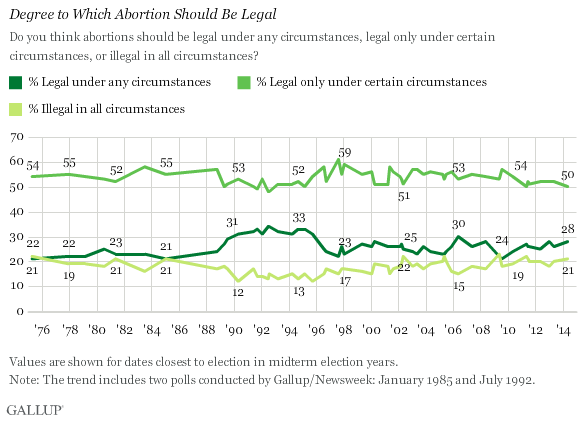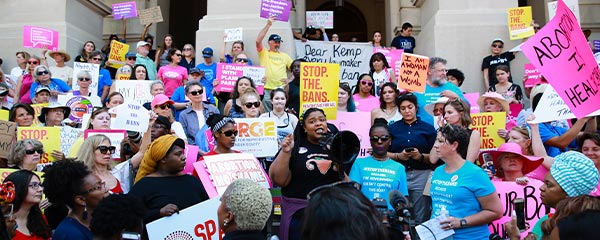PRINCETON, NJ -- Americans remain divided on the abortion issue, with 47% of U.S. adults describing their views as "pro-choice" and 46% as "pro-life," continuing a pattern seen since 2010.

These results are based on Gallup's annual Values and Beliefs survey, conducted May 8-11. Gallup's trend on this question stretches back to 1995, when Americans tilted significantly more toward the pro-choice label. The balance generally remained more in the pro-choice direction until 2009 when for the first time more Americans identified as pro-life than pro-choice. Since then, these attitudes have fluctuated some, but remain roughly split.
Abortion Views Are Most Unified in the East
Americans' identification with the two abortion politics labels differs somewhat by gender and age, with women and 18- to 34-year olds tilting pro-choice, and men and Americans aged 55 and older tilting pro-life. Middle-aged adults are evenly split on the issue.
Regionally, Easterners are the most unified, with 59% calling themselves pro-choice, whereas in all other regions, no more than 50% identify with either label. However, Southerners lean toward the pro-life position (49% to 41%), while those in the Midwest and West are about evenly split.
By far the biggest differences in these views are political, with over two-thirds of Republicans calling themselves pro-life and about as many Democrats identifying as pro-choice. Independents fall squarely in the middle.

The Moderate Middle Position Down to 50%
A second long-term Gallup trend, this one measuring Americans' views on the extent to which abortion should be legal, finds 50% saying abortion should be "legal only under certain circumstances," or in other words, favoring limited abortion rights. This stance has prevailed since 1975. However, a combined 49% of Americans takes a more hardline position, including 28% saying abortion should be legal in all circumstances and 21% believing it should be illegal in all circumstances.
Support for the strong anti-abortion rights position has hovered around 20% since 2011, just below the record-high 23% seen in 2009. Support for strong pro-abortion rights is a notch below the highest levels seen from 1990 to 1995 when it consistently exceeded 30%, but support is up from four to five years ago when it had dipped into the low 20s.

The abortion issue seemingly has been sidelined over the past several election cycles as a series of weighty issues -- including the Iraq War, the economy, and healthcare reform -- have dominated political debate. It is thus remarkable that the percentage of voters saying a candidate's position on abortion is paramount to their vote has not only remained constant, but has also increased slightly.
Nineteen percent of U.S. registered voters currently say candidates for major offices must share their views on abortion to get their vote. This number slightly eclipses the 16% to 17% seen since 2004 and is significantly higher than the 13% to 14% that Gallup recorded between 1992 and 2000. Only once, in May 2001, was the figure higher, at 21%.

Gallup finds more pro-life voters than pro-choice voters saying they will only back candidates who share their views, 24% vs. 16%. Thus, the pro-life side has more intensity on the issue. However, because there are more pro-choice than pro-life registered voters (50% to 44%), this equates to 11% of all registered voters saying they will only vote for pro-life candidates and 8% saying they will only vote for pro-choice candidates -- not a great advantage or disadvantage for either side.

Implications
U.S. public opinion on abortion has displayed great stability in recent years, with Americans dividing about evenly into the "pro-choice" and "pro-life" camps. Separately, Gallup finds roughly half of Americans retain a nuanced view about the legality of abortion, saying it should be legal only in certain cases. However, the percentages on the extremes -- those favoring total legality or illegality -- have crept up, presumably to the delight of their respective comrades in the Republican and Democratic parties.
In January, Jeremy W. Peters in a New York Times article described abortion as an "unexpectedly animating issue in the 2014 midterm elections," and referred back to the reported success that abortion rights groups had in 2012, both with modeling and targeting "women's health" voters. Indeed, Gallup finds that a quarter of Republican voters (24%) and 19% of Democratic voters claim they will only vote for a candidate who shares their views on abortion, making these voters prime targets for party turnout efforts. While their impact could result in a draw on the abortion issue, it is a battle neither party can afford to ignore.
Survey Methods
Results for this Gallup poll are based on telephone interviews conducted May 8-11, 2014, with a random sample of 1,028 adults, aged 18 and older, living in all 50 U.S. states and the District of Columbia.
For results based on the total sample of national adults, the margin of sampling error is ±4 percentage points at the 95% confidence level.
For results based on the total sample of 888 registered voters, the margin of sampling error is ±4 percentage points at the 95% confidence level.
Interviews are conducted with respondents on landline telephones and cellular phones, with interviews conducted in Spanish for respondents who are primarily Spanish-speaking. Each sample of national adults includes a minimum quota of 50% cellphone respondents and 50% landline respondents, with additional minimum quotas by time zone within region. Landline and cellular telephone numbers are selected using random-digit-dial methods. Landline respondents are chosen at random within each household on the basis of which member had the most recent birthday.
Samples are weighted to correct for unequal selection probability, nonresponse, and double coverage of landline and cell users in the two sampling frames. They are also weighted to match the national demographics of gender, age, race, Hispanic ethnicity, education, region, population density, and phone status (cellphone only/landline only/both, and cellphone mostly). Demographic weighting targets are based on the most recent Current Population Survey figures for the aged 18 and older U.S. population. Phone status targets are based on the most recent National Health Interview Survey. Population density targets are based on the most recent U.S. census. All reported margins of sampling error include the computed design effects for weighting.
In addition to sampling error, question wording and practical difficulties in conducting surveys can introduce error or bias into the findings of public opinion polls.
For more details on Gallup's polling methodology, visit www.gallup.com.
